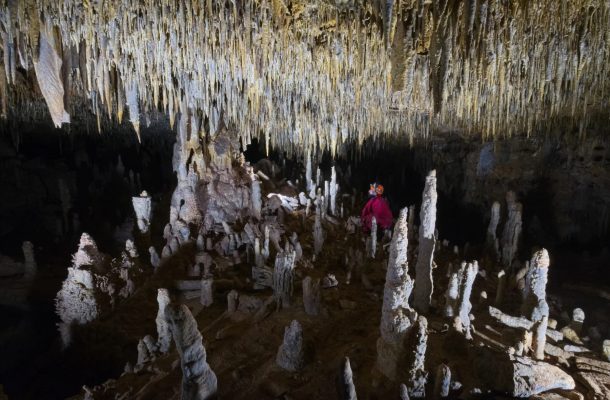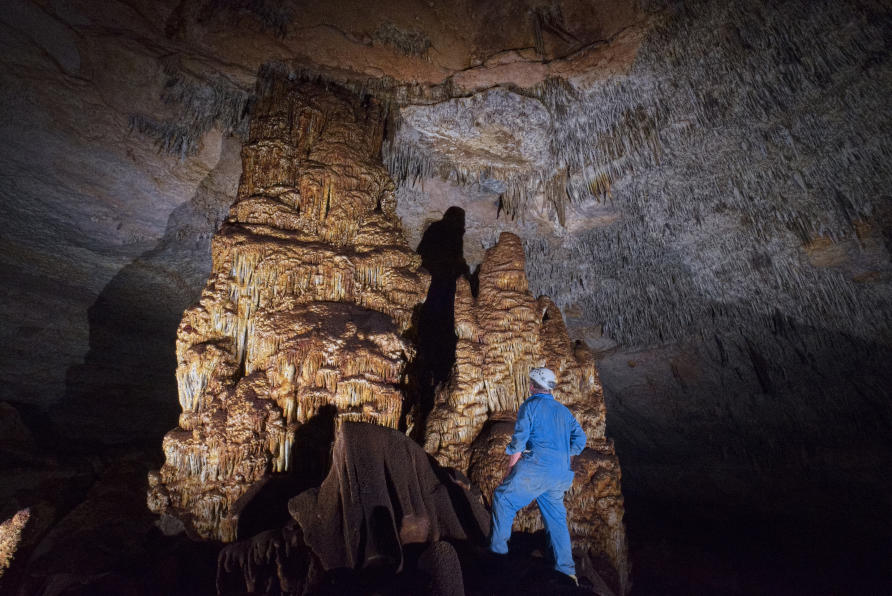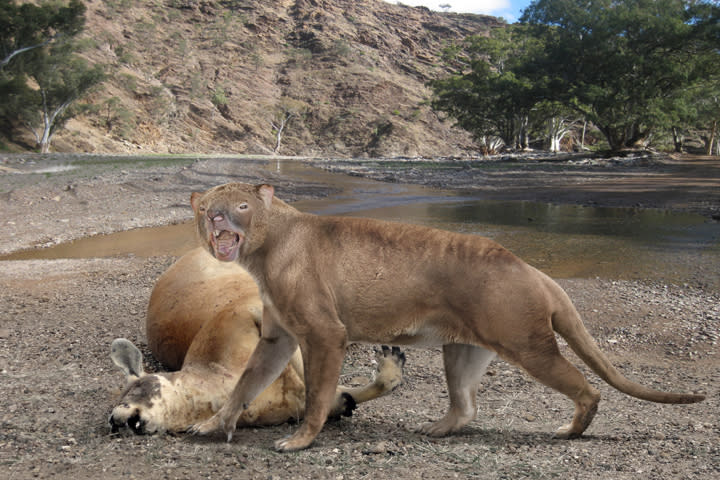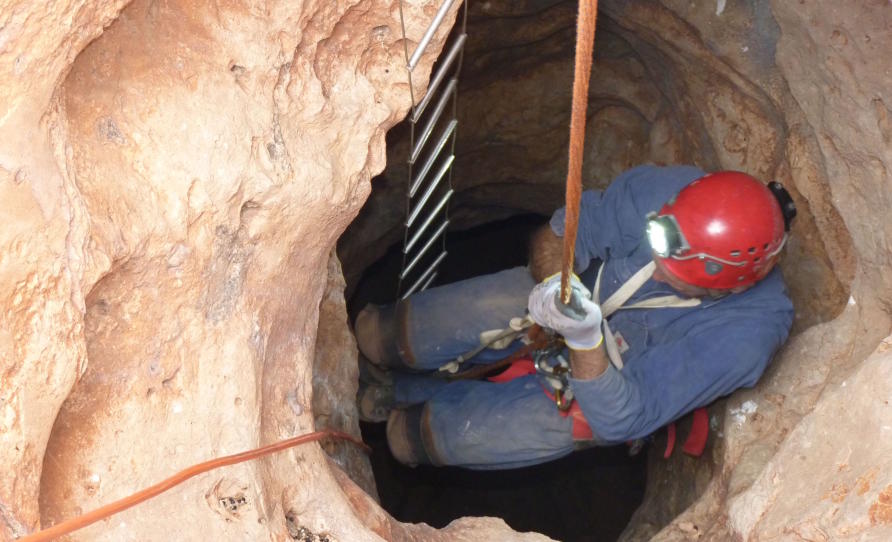It’s time the Nullarbor caves had world heritage status

Many children dream of travelling back in time to a land populated by dinosaurs.
Unfortunately, while Einstein’s special theory of relativity suggests that travelling forward in time is theoretically possible if we approach the speed of light, the chances of doing so in reverse appear remote.
There are, however, rare places that you can visit – especially here in Australia – where time has stood still for millions of years, allowing us a glimpse into a very different world when our continent was far less arid than today. These places are ancient underground caves and to walk into them is perhaps as close as we can come to stepping back in time.
For most travellers, the desert-like Nullarbor Plain is primarily an encumbrance; notorious only for the considerable time required to traverse its vast landscape.
Indeed, ‘crossing the Nullarbor’ has become a rite of passage for generations of Australians. But the Plain is a mecca for scientists and holds a subterranean secret – its enormous network of shallow caves spread over an area of more than 100,000 square kilometres.
Rarely visited except by avid cavers, the age and origin of the Nullarbor Caves has remained a subject of debate for many decades.
The problem is simple: caves require water, and generally lots of it, to form and yet the region today is semi-arid, receiving on average only 180-270 millimetres of precipitation a year (compared with Sydney’s 1200 millimetres per year).
Clearly these caves belong to a time in our distant past.
Solving the riddle
The key to solving this riddle lay in the development of new technologies to date the geological formations found inside caves like stalagmites and stalactites.
In new research published in Nature Scientific Reports we demonstrate the great antiquity of the Nullarbor cave systems, which formed almost entirely in the Pliocene epoch some three to five million years ago.
Amazingly, even the most delicate of cave formation like the thin ‘soda straws’ (hollow tubular stalagmites) have survived seemingly untouched since this time. These are, in effect, ancient worlds ‘frozen in time’ – an accidental product of Australia’s drift into aridity some 2.5 million years ago which effectively shut down many of the geological processes that might have otherwise obliterated these landscapes.

This ancient ‘cavescape’ is almost certainly unique worldwide and provides a vast natural laboratory for the study of ancient climates – in this case one particularly relevant to our future since the Pliocene is regarded as the best geological comparison for global warming.
Through chemical signals preserved when cave formations grew we can reconstruct temperature, and likely precipitation levels at the time of formation, and even extract fossil pollens to reconstruct contemporary vegetation profiles. The Nullarbor caves are also famous for their fossils like the exceptionally well-preserved vertebrate faunas from the mid-Pleistocene Epoch (around 130,000-780,000 thousand years ago), including the magnificent marsupial lion – Thylacoleo carnifex – which has been found here.
So it’s surprising that the region has received such little recognition.
The Nullarbor Caves meet many of the outstanding universal value criteria for World Heritage listing – they contain “superlative natural phenomena” and are “an outstanding example representing a major stage of Earth’s history”.
Globally, similar landscapes marked by underground caves and sinkholes (called karst terrain) have achieved World Heritage status, including the Mammoth cave in Kentucky State in the US, the Mulu National Park in Malaysia’s Sarawak, and the South China Karst.
Balancing recognition with protection
In Australia, however, only two regions – the Naracoorte caves of South Australia and the now collapsed caves of Riversleigh in Northern Australia – have attained World heritage listing, based in both cases, on their outstanding mammal fossils.
Despite their unique attributes, the caves of the Nullarbor have, unfortunately not yet received such accolades.
A report commissioned by the Commonwealth government in 1992 on the suitability of the region for World Heritage listing wasn’t supported at the time. Indeed, only one cave in the Nullarbor – Koonalda – has even made it onto Australia’s own National Heritage list of places with “outstanding significance to the nation”.
That was in 2014, and largely in recognition of the role it has played in our understanding of Aboriginal art and occupation.

How best then to recognise and preserve the unique caves of the Nullarbor?
Unfortunately, this is a complex problem. The region is huge – it is the world’s largest exposed karst terrain and spans two states. It encompasses many pastoral leases, Crown land, and areas of native title claim.
Also, with the exception of a few larger caves which are well known, like Cocklebiddy which is one of the world’s longest cave dives, the locations of most ‘wild caves’ are closely guarded secrets and so could never be opened up to larger scale tourism ventures.
The reasons for secrecy are obvious – for as long as humans have taken an interest in caves there have been people willing to remove or vandalise cave formations.

The lure of megafaunal remains has also attracted rogue fossil collectors intent on plundering caves for financial gain. In addition, many of the caves are refuges for important cave-dwelling invertebrates such as crustaceans, centipedes and spiders.
But not all the caves need to be kept secret and there may be a future role for limited adventure tourism operations in the Nullarbor, offering the prospect of ‘time travel’.
Whatever their future holds, the Nullarbor caves are, undeniably, one of the few landscapes on Earth that have survived intact for close to five million years.
We should make every effort possible to preserve them for future generations. They are a National treasure, and should be part of our national conversation.
This article was published by Pursuit.













